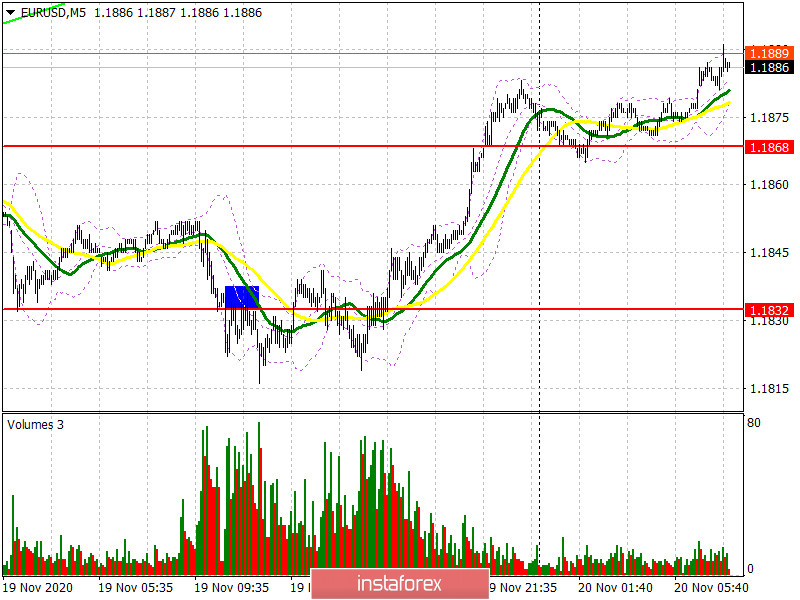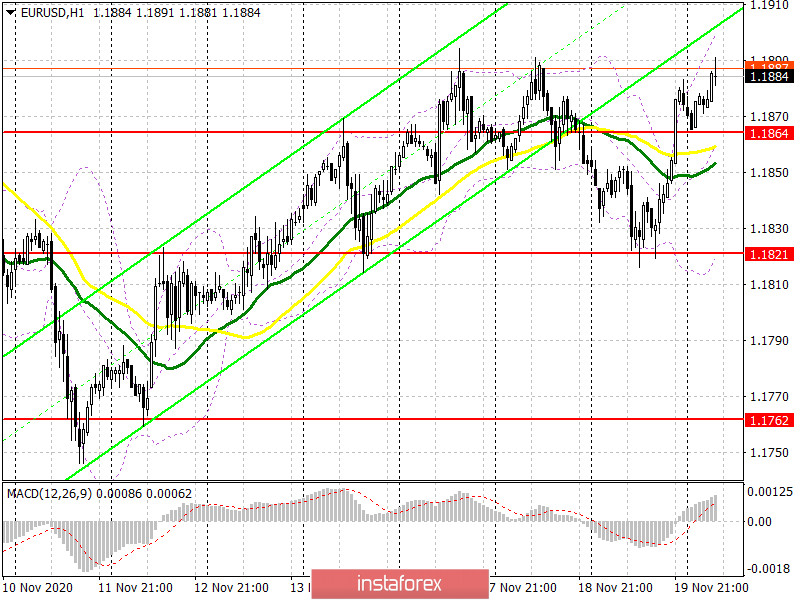To open long positions on EUR/USD, you need:
Yesterday, we could not wait for some kind of adequate signal to appear in order to enter the market, since trading was mainly conducted around the 1.1832 level and it has now undergone some changes. The euro grew in the afternoon, right after the release of a weak report on the US labor market, which went even beyond the forecasts of economists, thereby putting pressure on the US dollar.

Now the bears are aiming for a monthly high of 1.1915, but it will be difficult to break above this range. Today's absence of important fundamental statistics may keep the pair in the horizontal channel. Therefore, the primary task is to protect support at 1.1864, below which the moving averages pass, playing on the side of the bulls. Forming a false breakout there forms a good entry point for long deals, in hopes to return and update resistance at 1.1915. Being able to settle above this range will open a direct road to the highs of 1.1964 and 1.2008, where I recommend taking profits. If it is not active in the 1.1864 area, and trading moves below this range, it is better not to rush to buy, but wait until a larger low of 1.1821 has been updated, where the market reversed yesterday. However, it is best to open long positions from it if a false breakout is formed. It is possible to buy EUR/USD immediately on a rebound only at a low of 1.1762, counting on a correction of 15-20 points within the day.
To open short positions on EUR/USD, you need:
The initial challenge for sellers is to regain control of the 1.1864 level, which they missed yesterday afternoon. Being able to settle below this range and testing it from the bottom up produces a more convenient entry point to short positions in hopes of bringing back the downward trend. In this case, the 1.1821 level will be the nearest goal, which appeared yesterday afternoon. We can only say that sellers have complete control of the market when we have settled below 1.1821, which will lead to an instant sale of the euro to the area of a low of 1.1762, where I recommend taking profit. In case the euro grows further, especially after the speech of European Central Bank President Christine Lagarde, the bears will have to try very hard to protect resistance at 1.1915. Forming a false breakout there will be a signal to open short positions. I recommend selling EUR/USD immediately on a rebound from the high of 1.1964, counting on a downward correction of 15-20 points within the day.

The Commitment of Traders (COT) report for November 10 showed a reduction in long and short positions. Euro bulls are holding on to a wait-and-see attitude and are in no hurry to return to the market even after the US presidential elections. Despite this, buyers of risky assets believe that the bull market will continue, although they prefer to proceed with caution. Thus, long non-commercial positions decreased from 208,237 to 202,374, while short non-commercial positions remained practically unchanged, falling from 67,888 to 67,087. The total non-commercial net position decreased to 135,287 against 140,349 a week earlier. It is worth noting that the delta has been declining for seven consecutive weeks, which confirms the buyers' lack of desire to enter the market in the current conditions. Growth will only begin after Joe Biden's victory and once his plan is implemented, as he intends to endow the American economy with the next largest monetary aid package worth more than $2 trillion.
Indicator signals:
Moving averages
Trading is carried out just above 30 and 50 moving averages, which indicates the likelihood of the euro's succeeding growth.
Note: The period and prices of moving averages are considered by the author on the H1 hourly chart and differs from the general definition of the classic daily moving averages on the daily D1 chart.
Bollinger Bands
A breakout of the upper border of the indicator in the 1.1905 area may lead to a new wave of euro growth. In case the pair falls, support will be provided by the lower border of the indicator at 1.1821.
Description of indicators
- Moving average (moving average, determines the current trend by smoothing out volatility and noise). Period 50. It is marked in yellow on the chart.
- Moving average (moving average, determines the current trend by smoothing out volatility and noise). Period 30. It is marked in green on the chart.
- MACD indicator (Moving Average Convergence/Divergence — convergence/divergence of moving averages) Quick EMA period 12. Slow EMA period to 26. SMA period 9
- Bollinger Bands (Bollinger Bands). Period 20
- Non-commercial speculative traders, such as individual traders, hedge funds, and large institutions that use the futures market for speculative purposes and meet certain requirements.
- Long non-commercial positions represent the total long open position of non-commercial traders.
- Short non-commercial positions represent the total short open position of non-commercial traders.
- Total non-commercial net position is the difference between short and long positions of non-commercial traders.





















